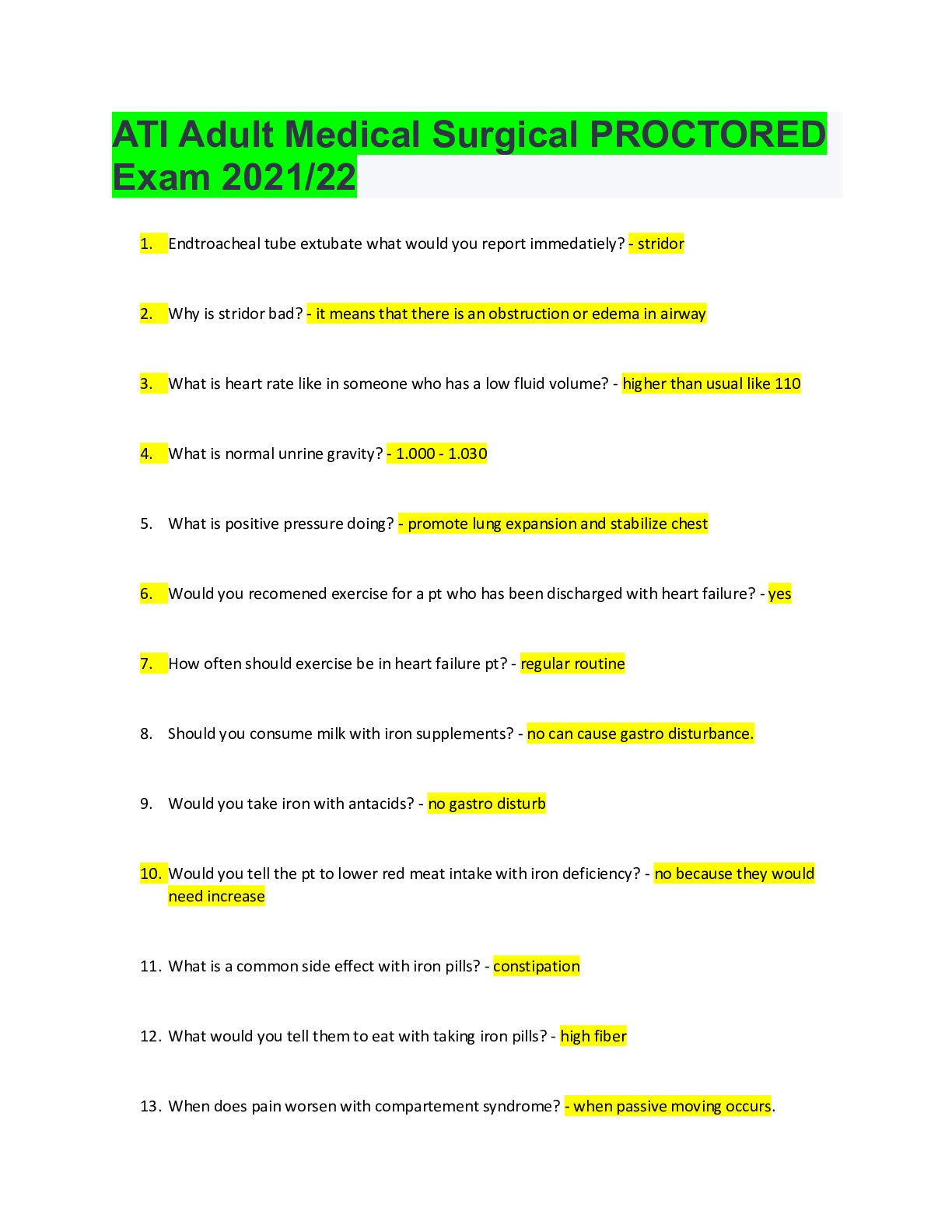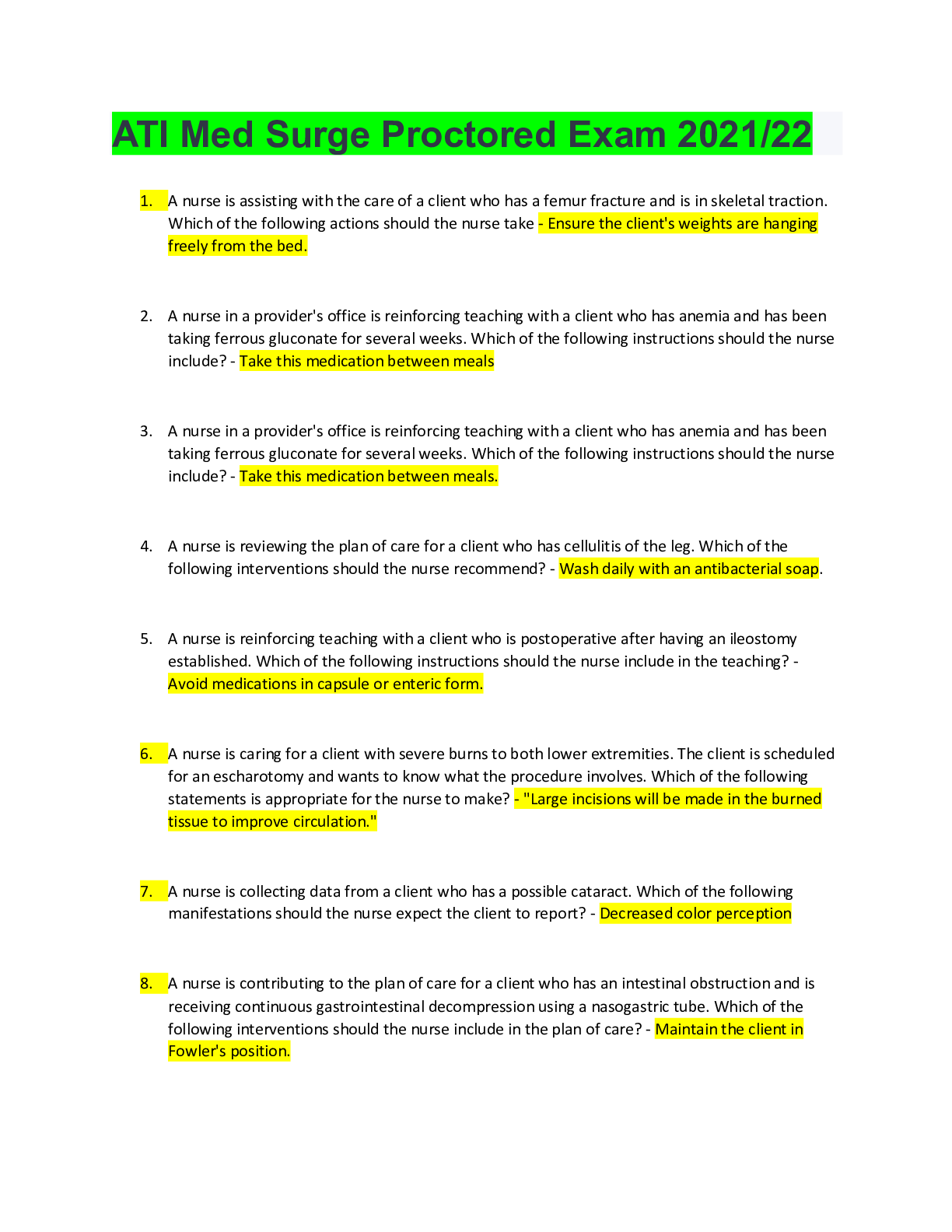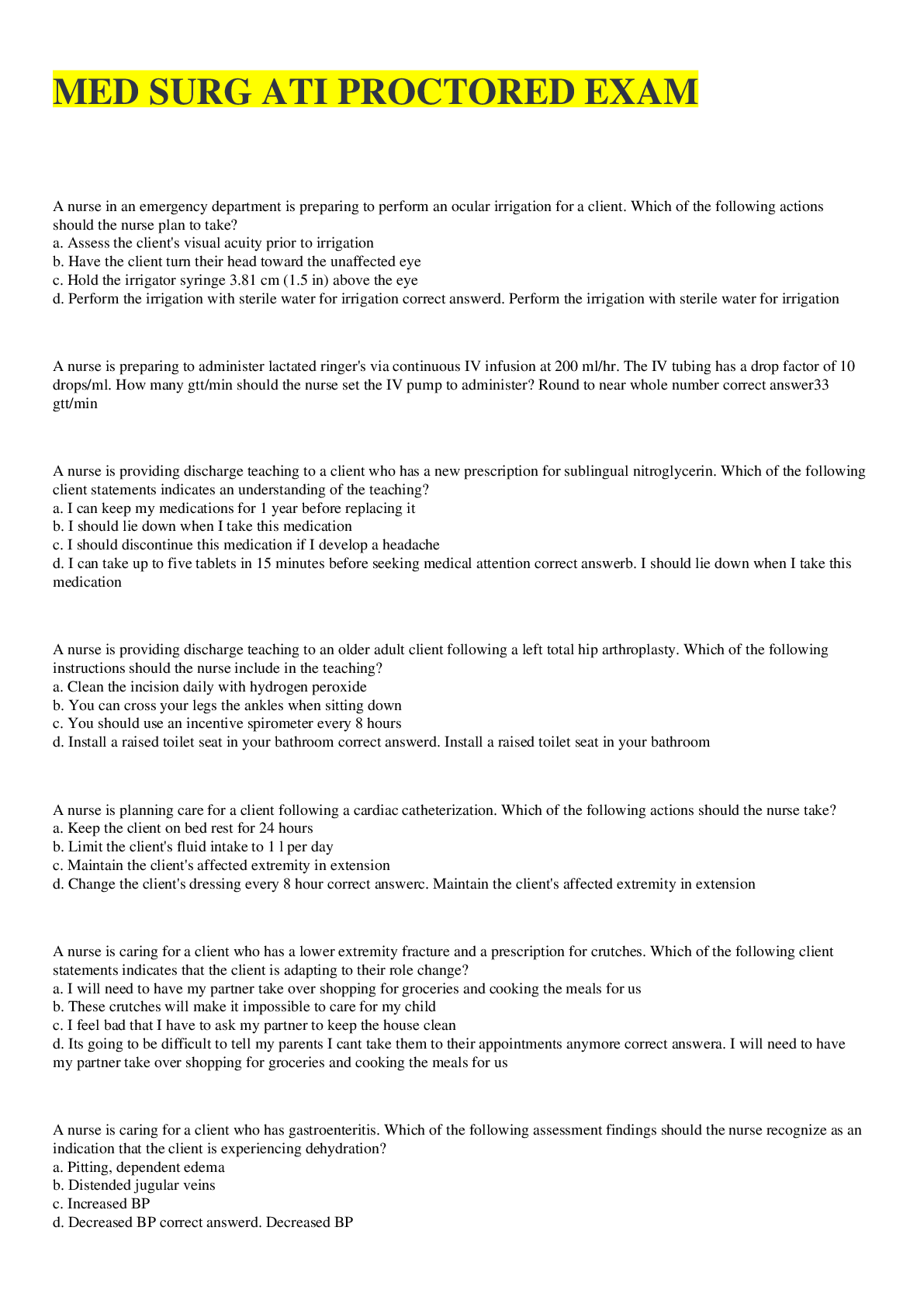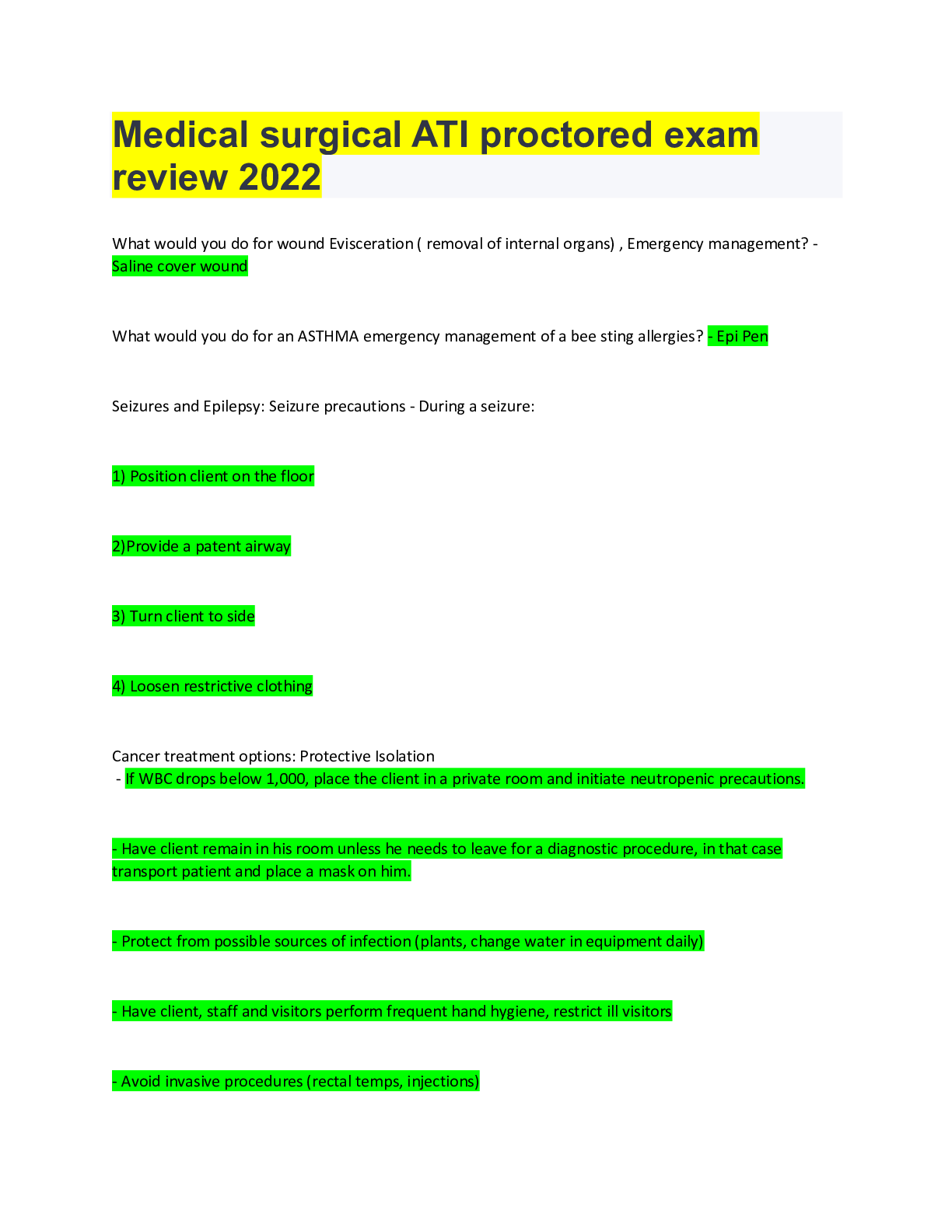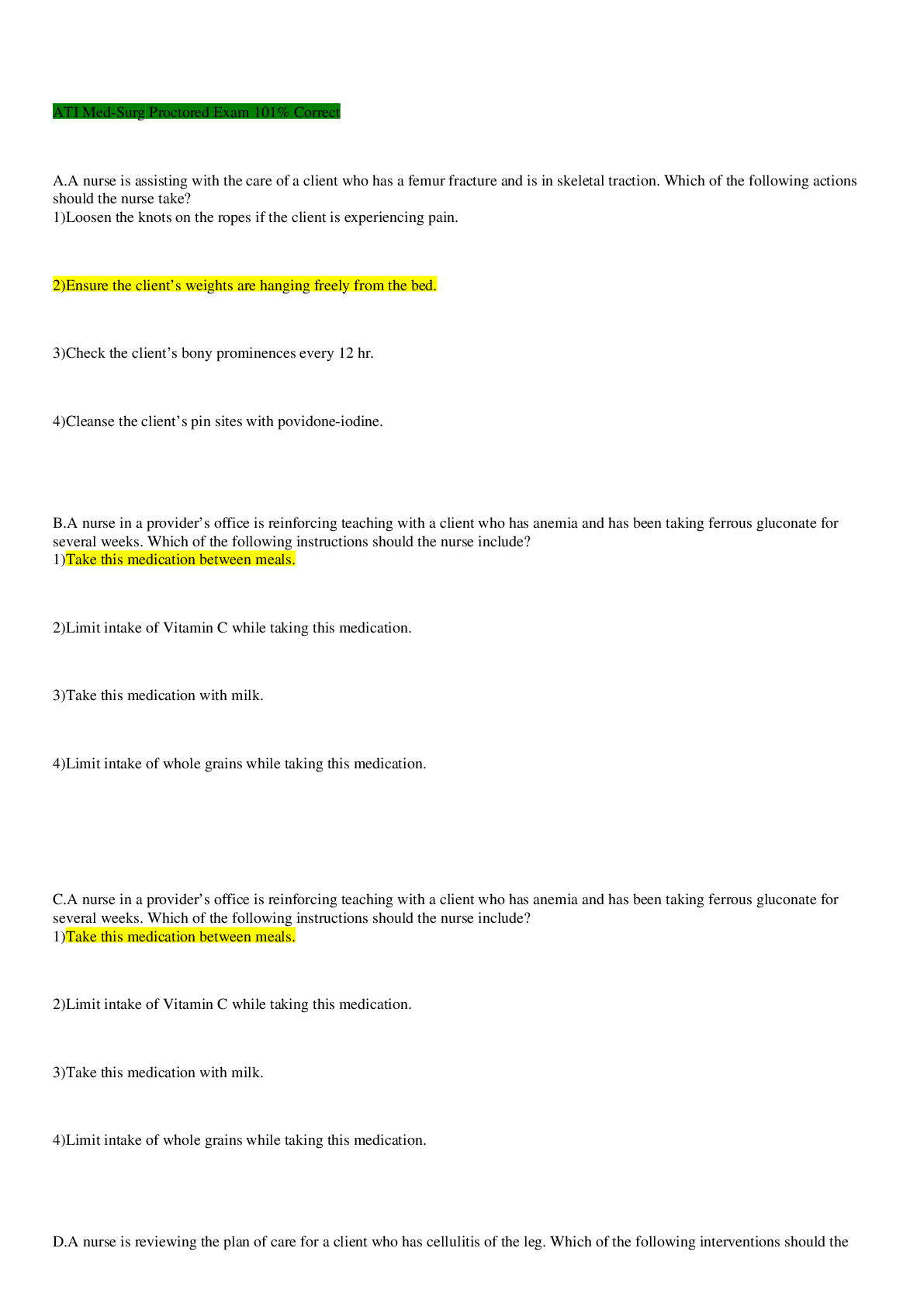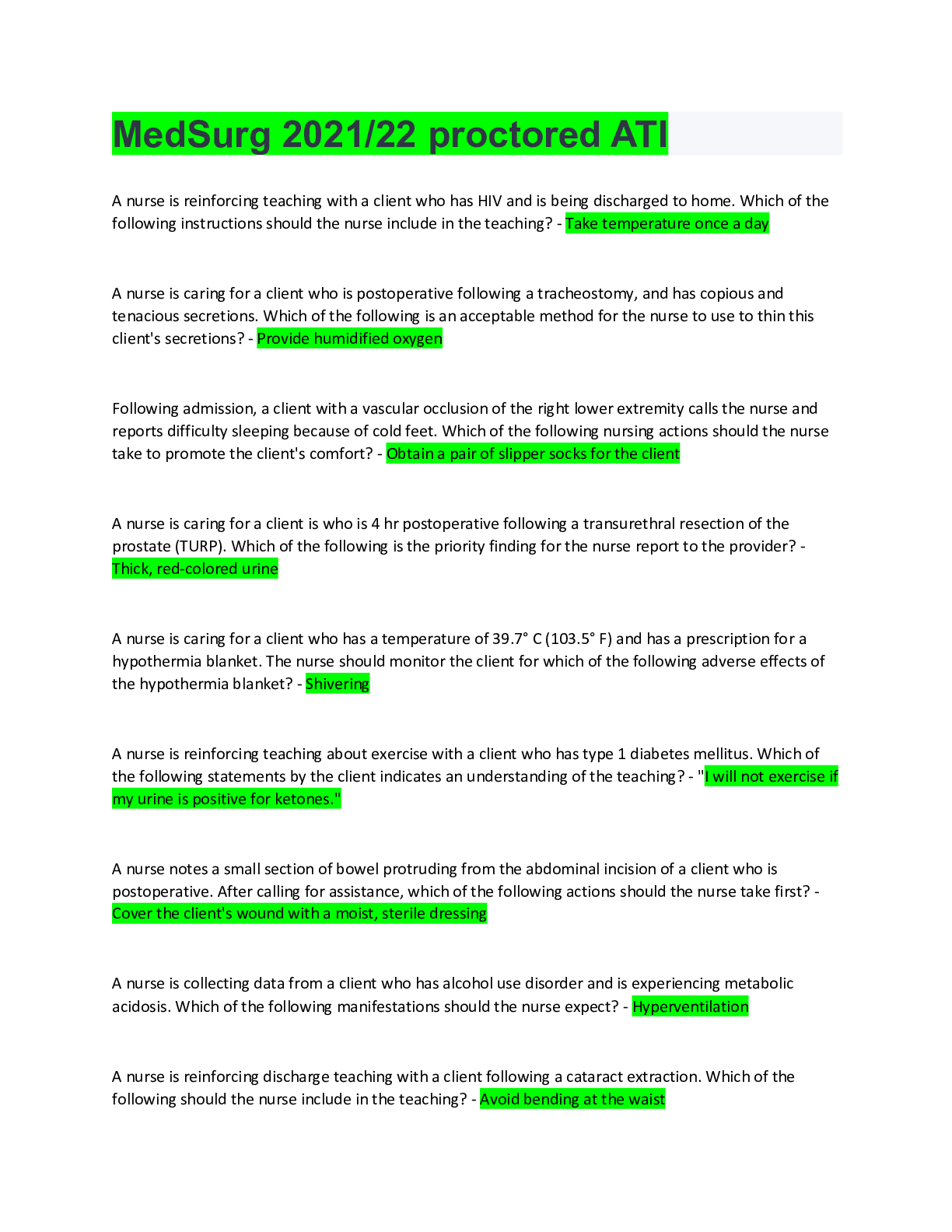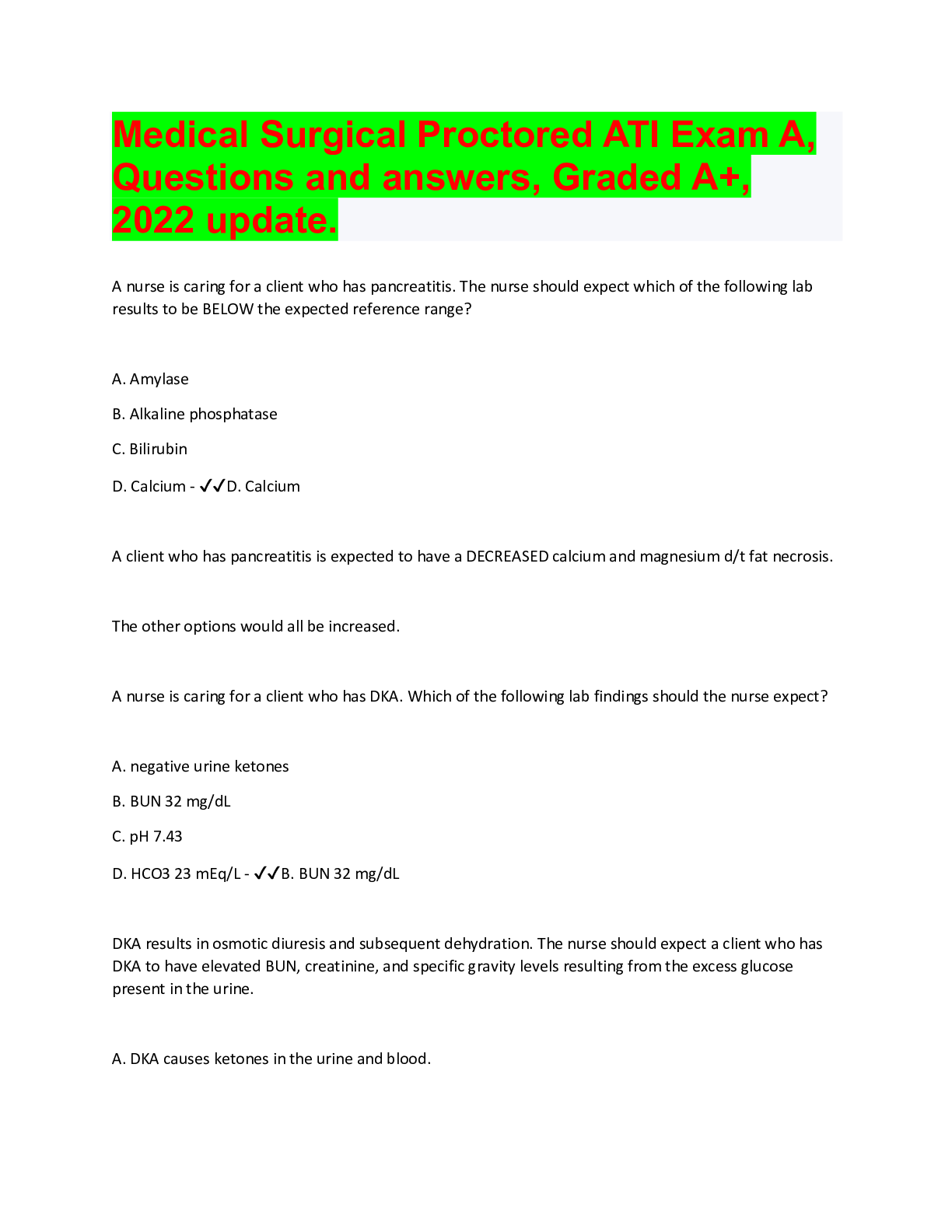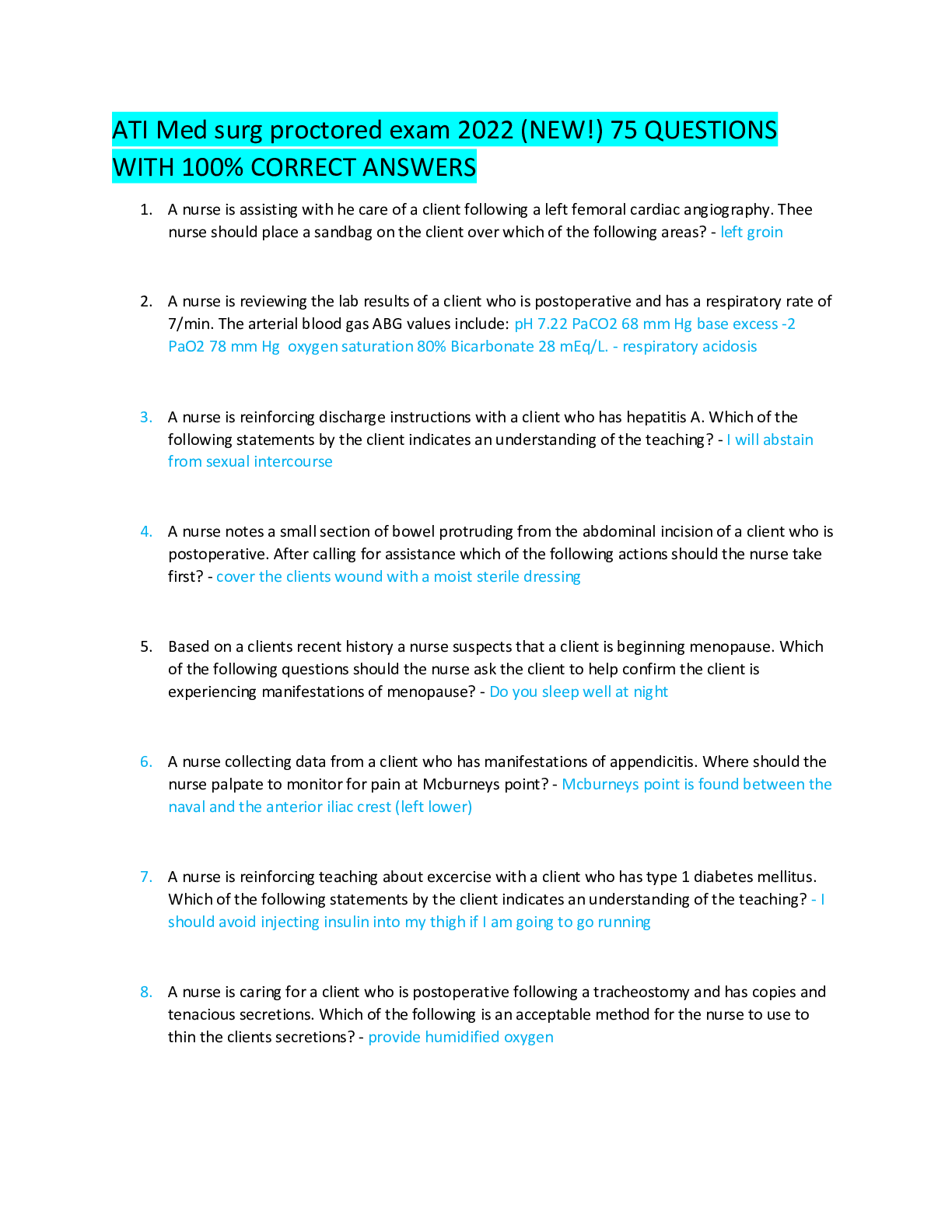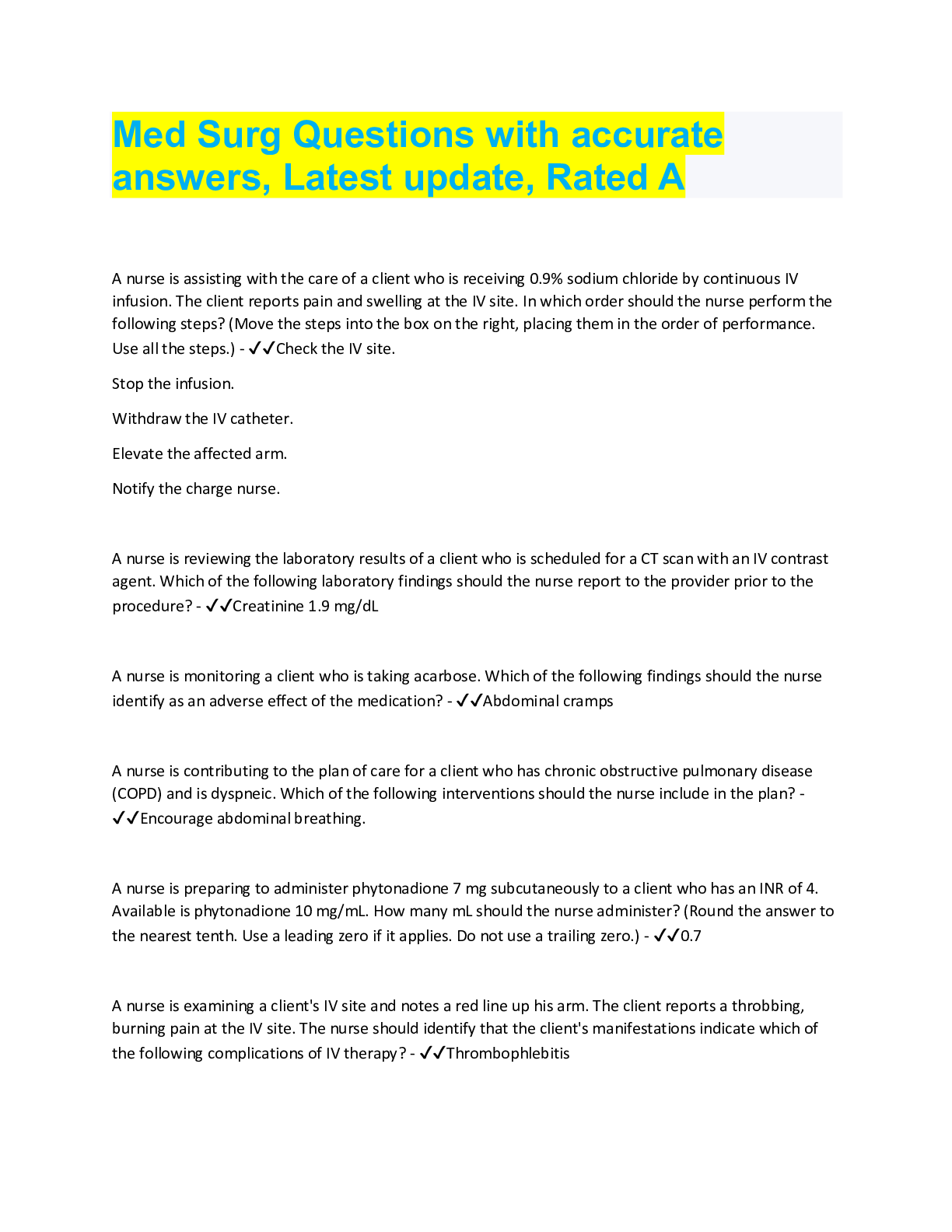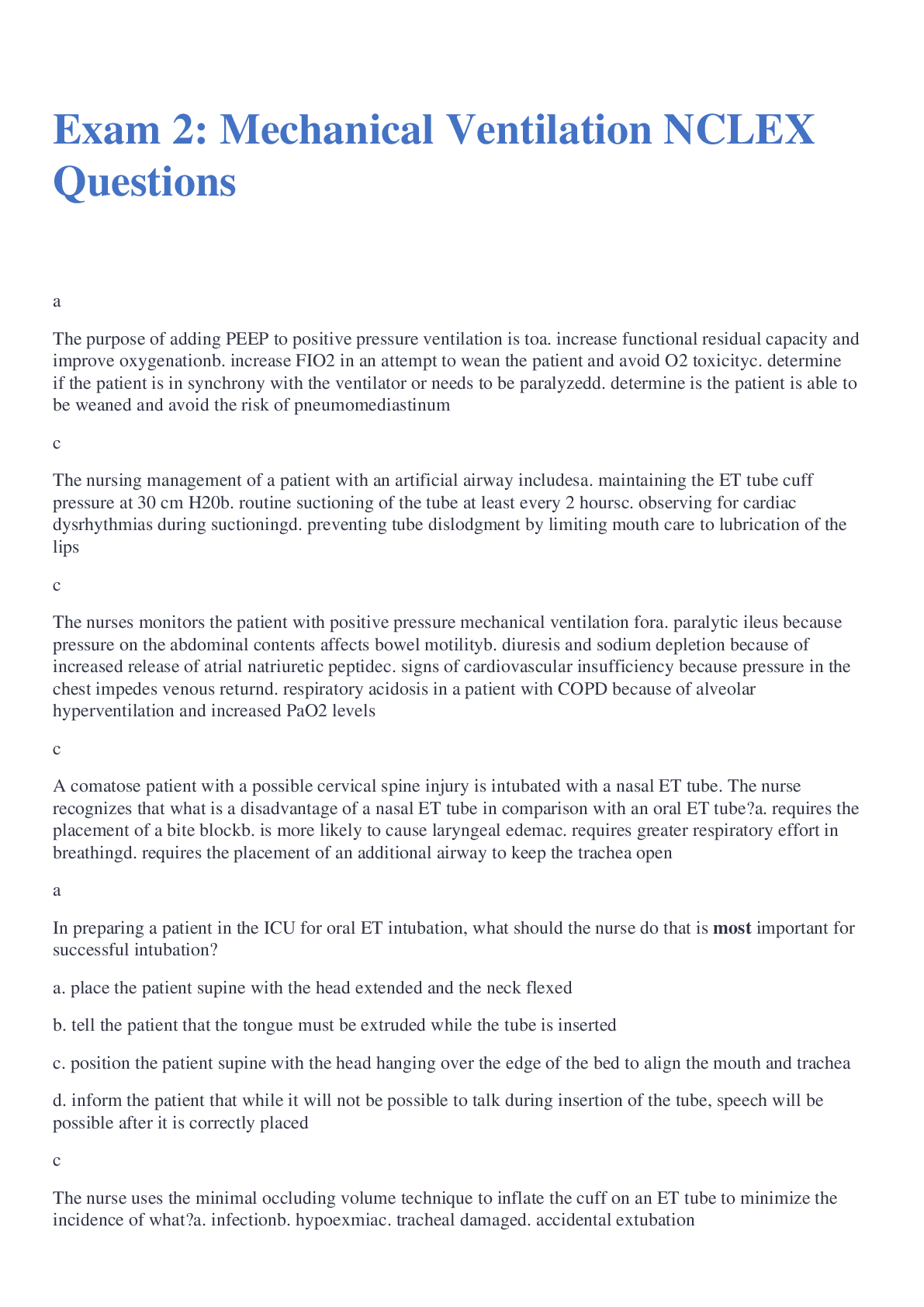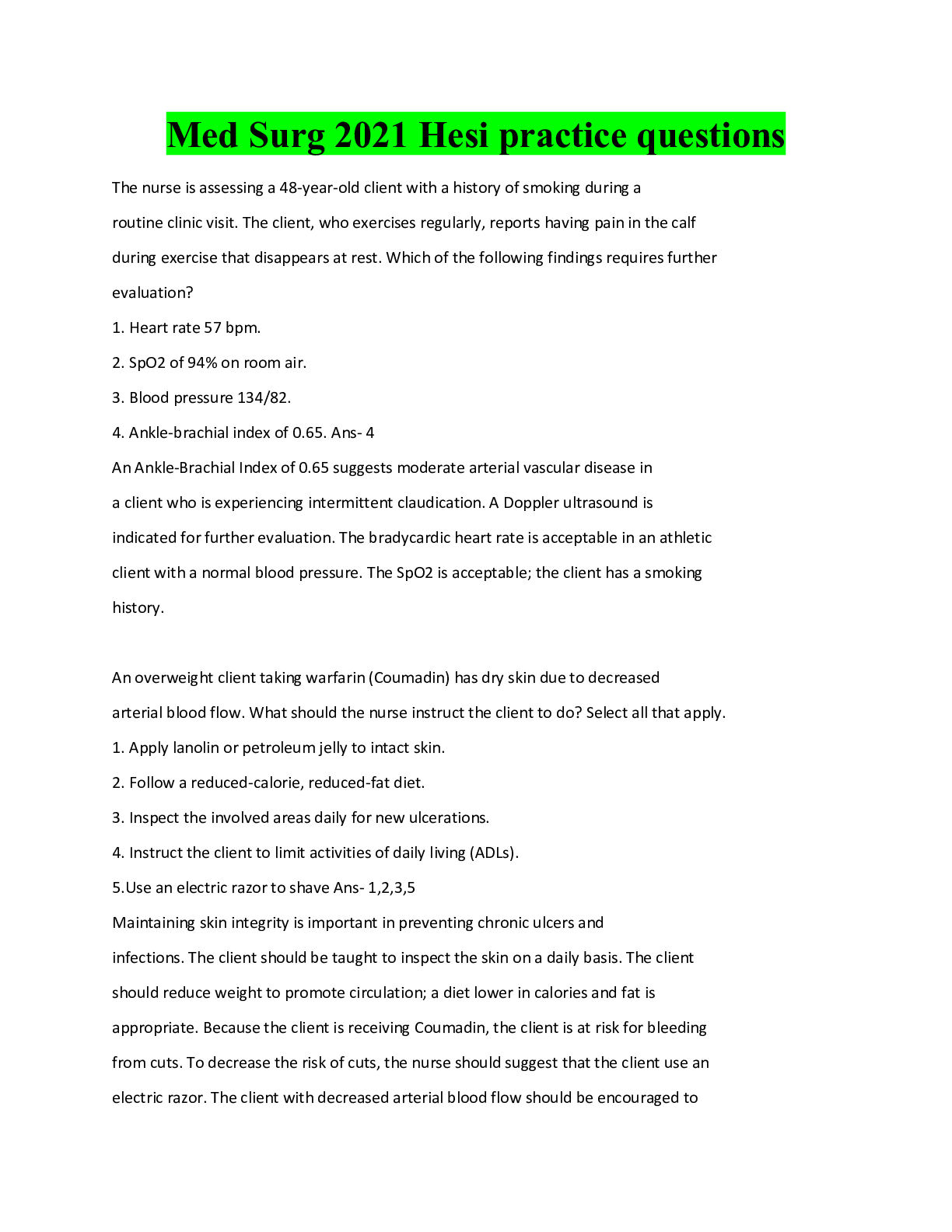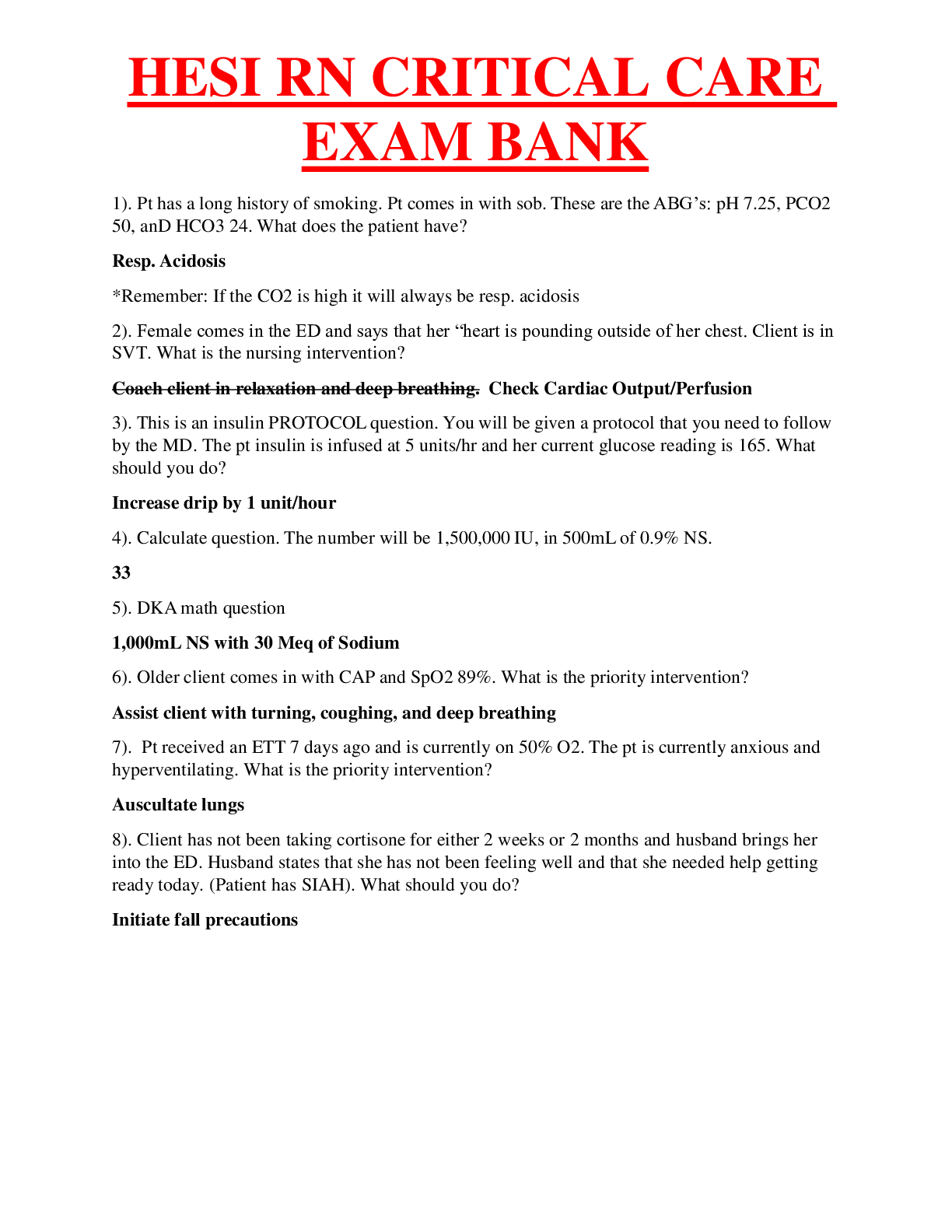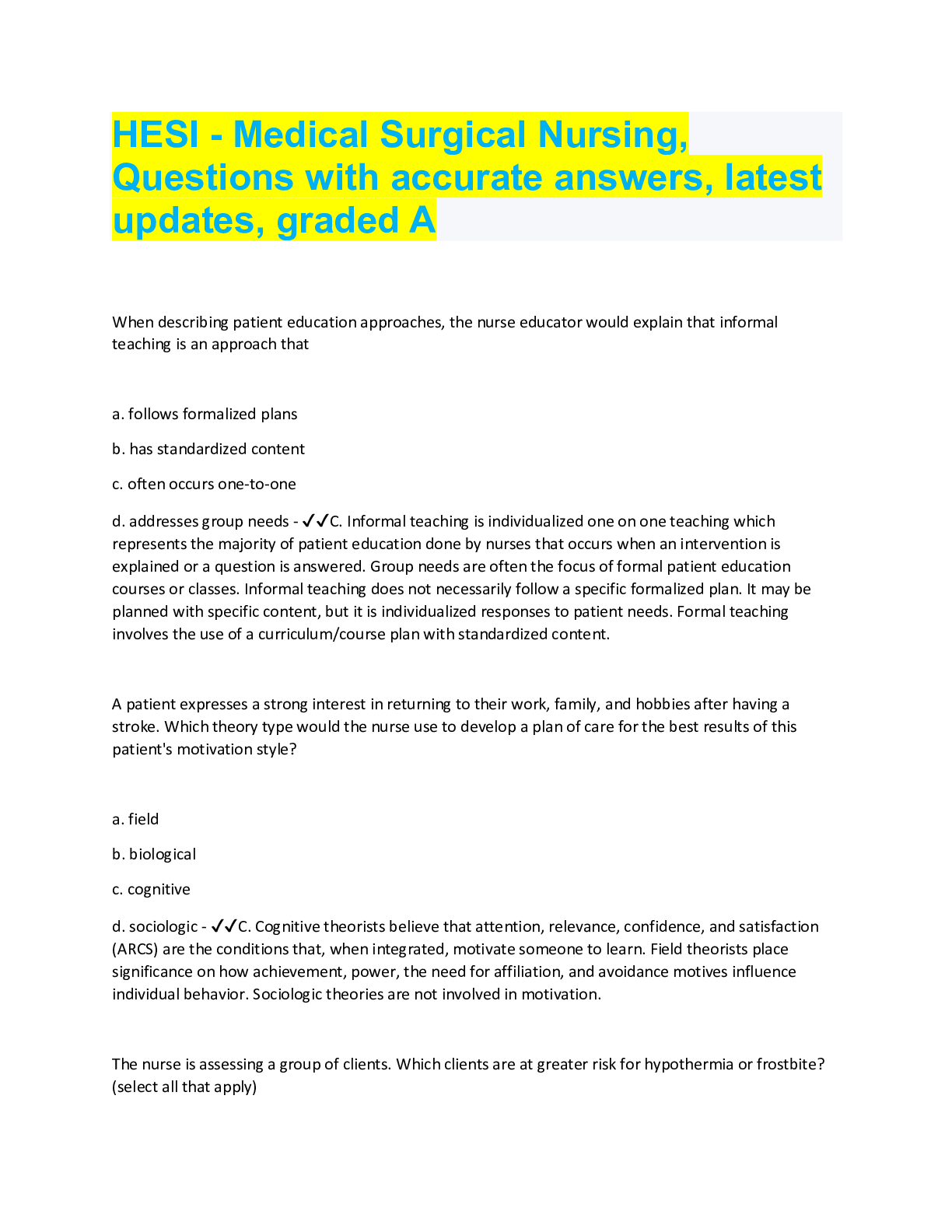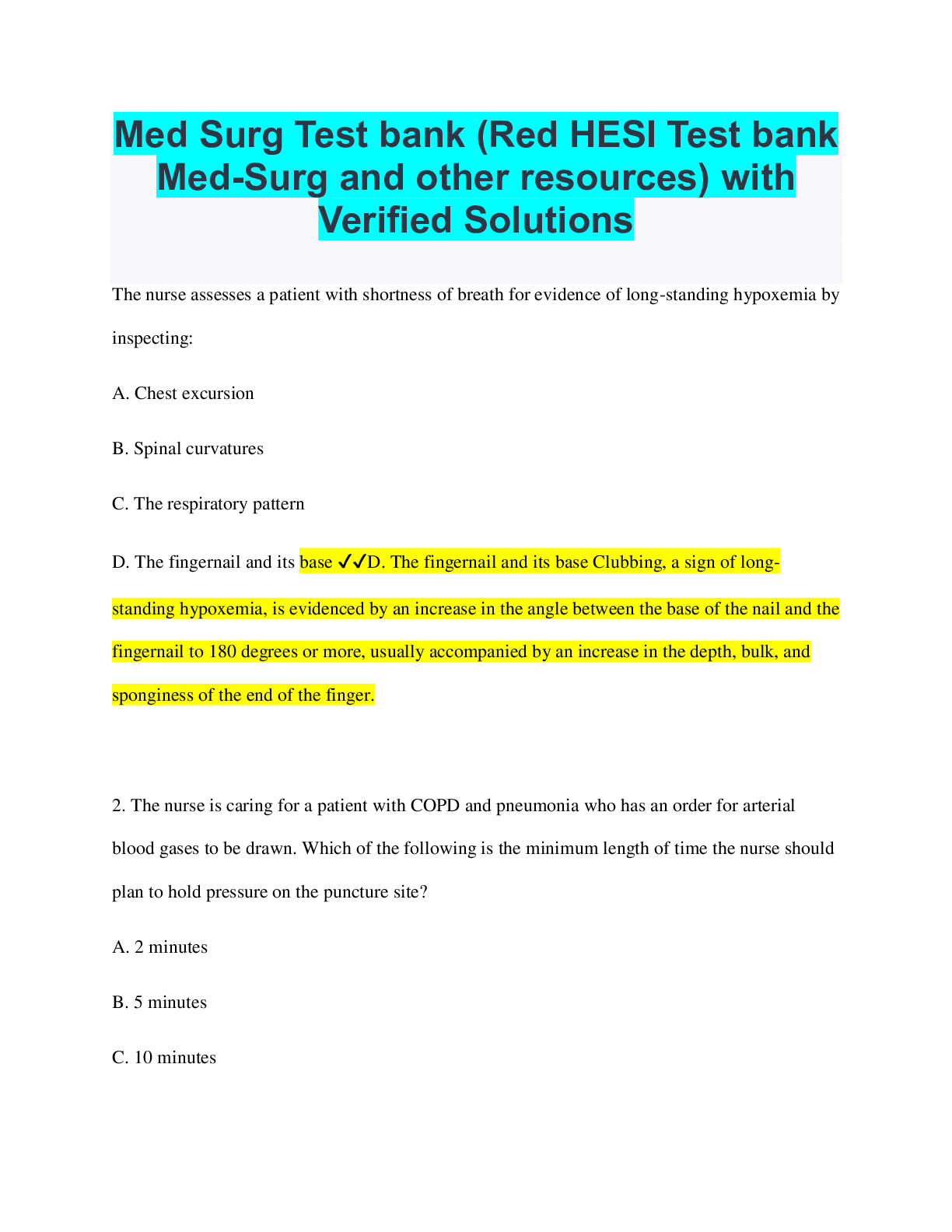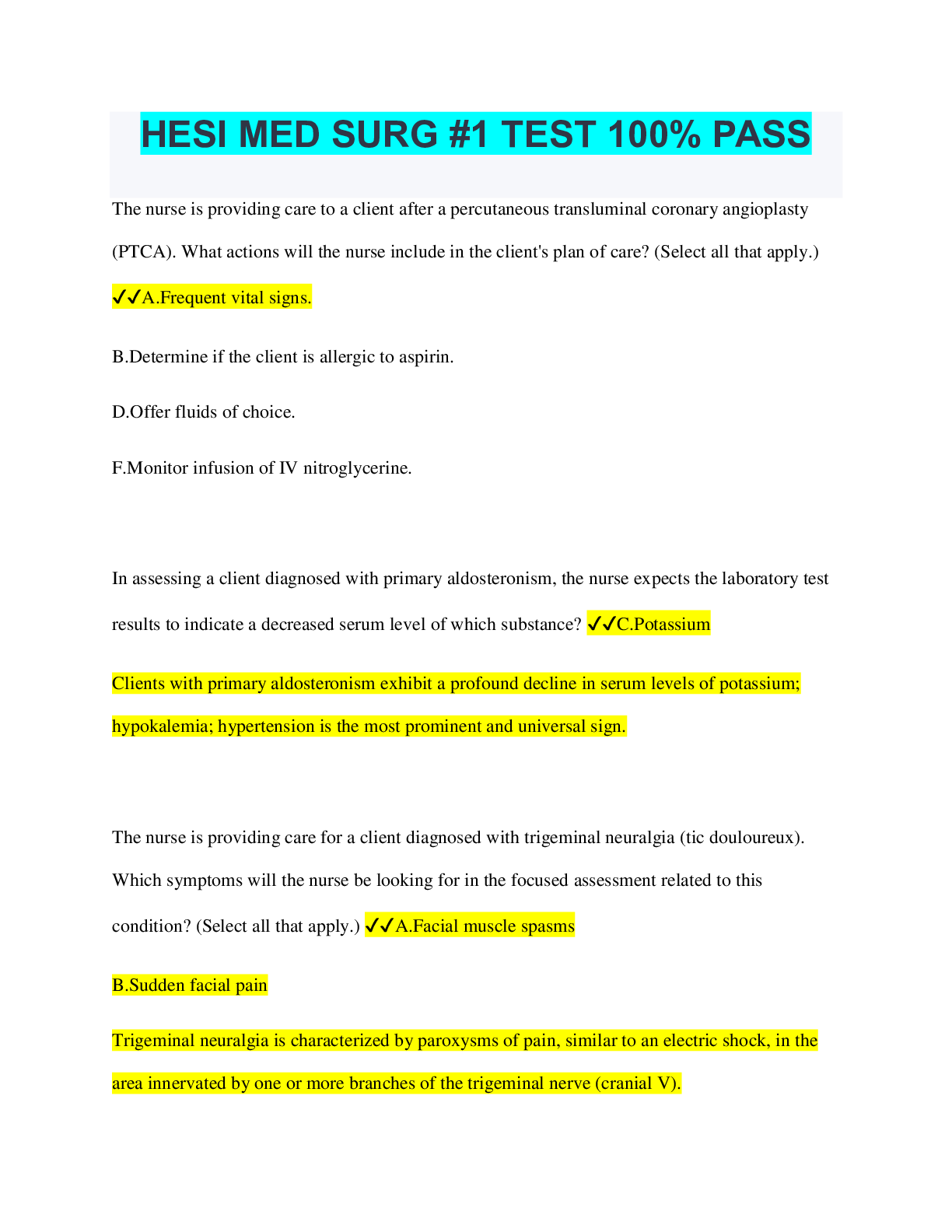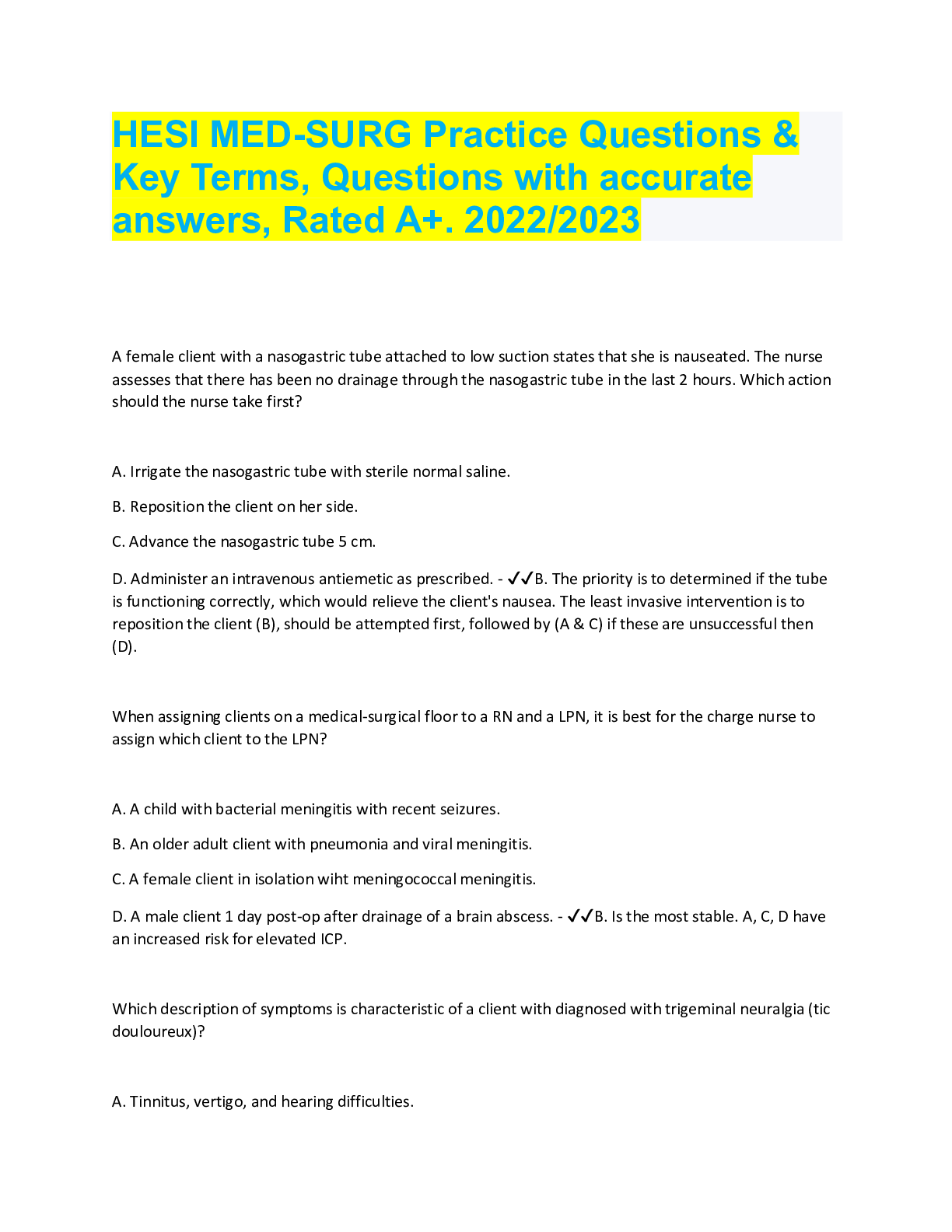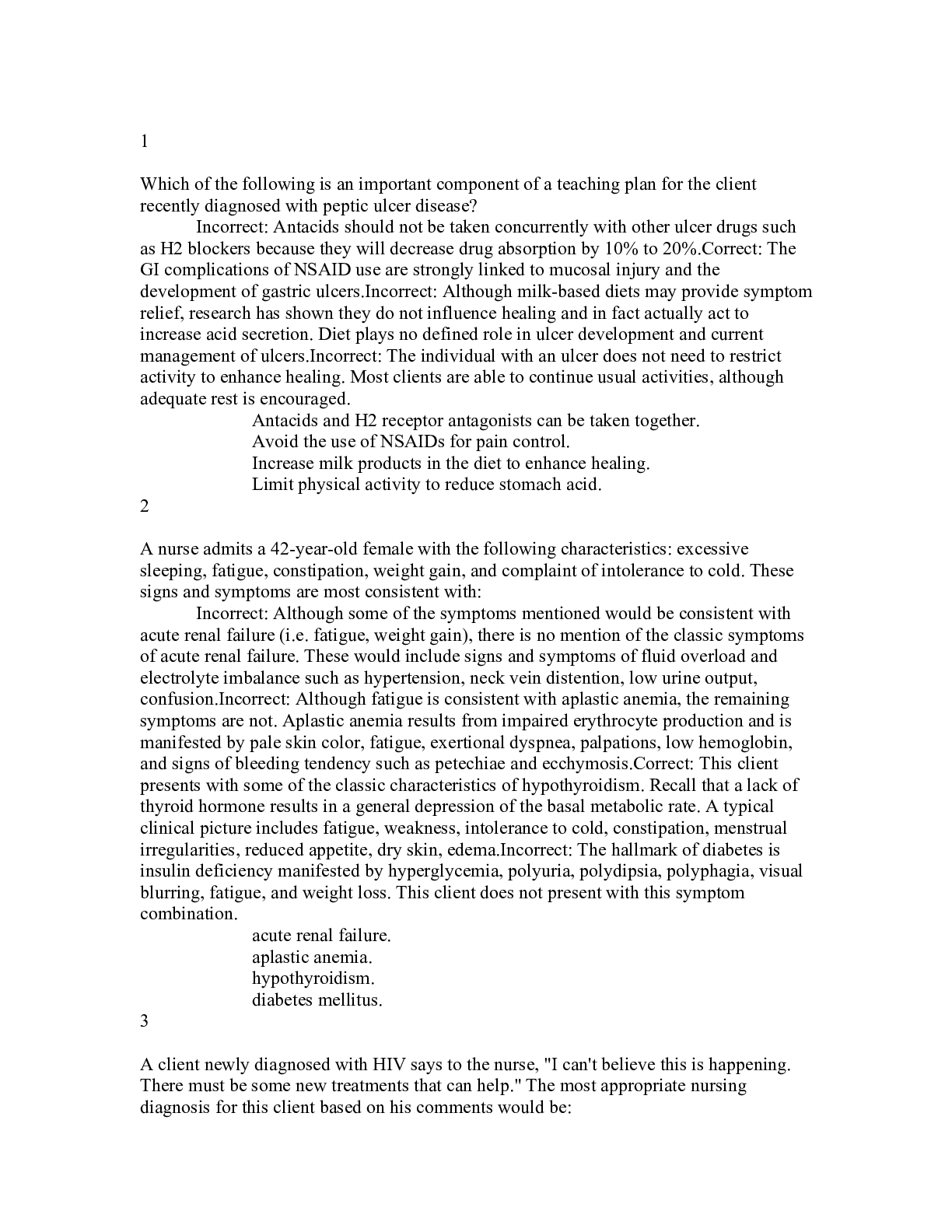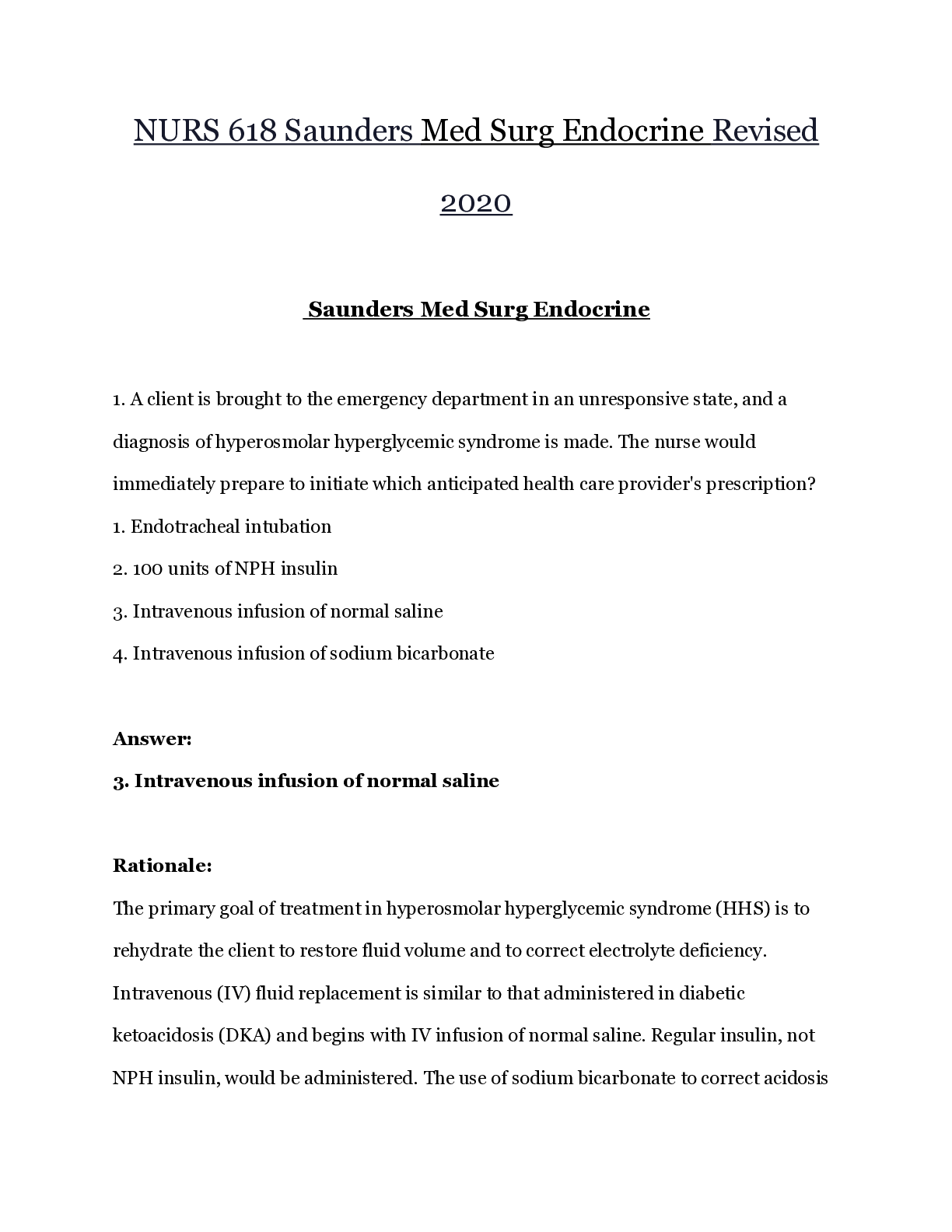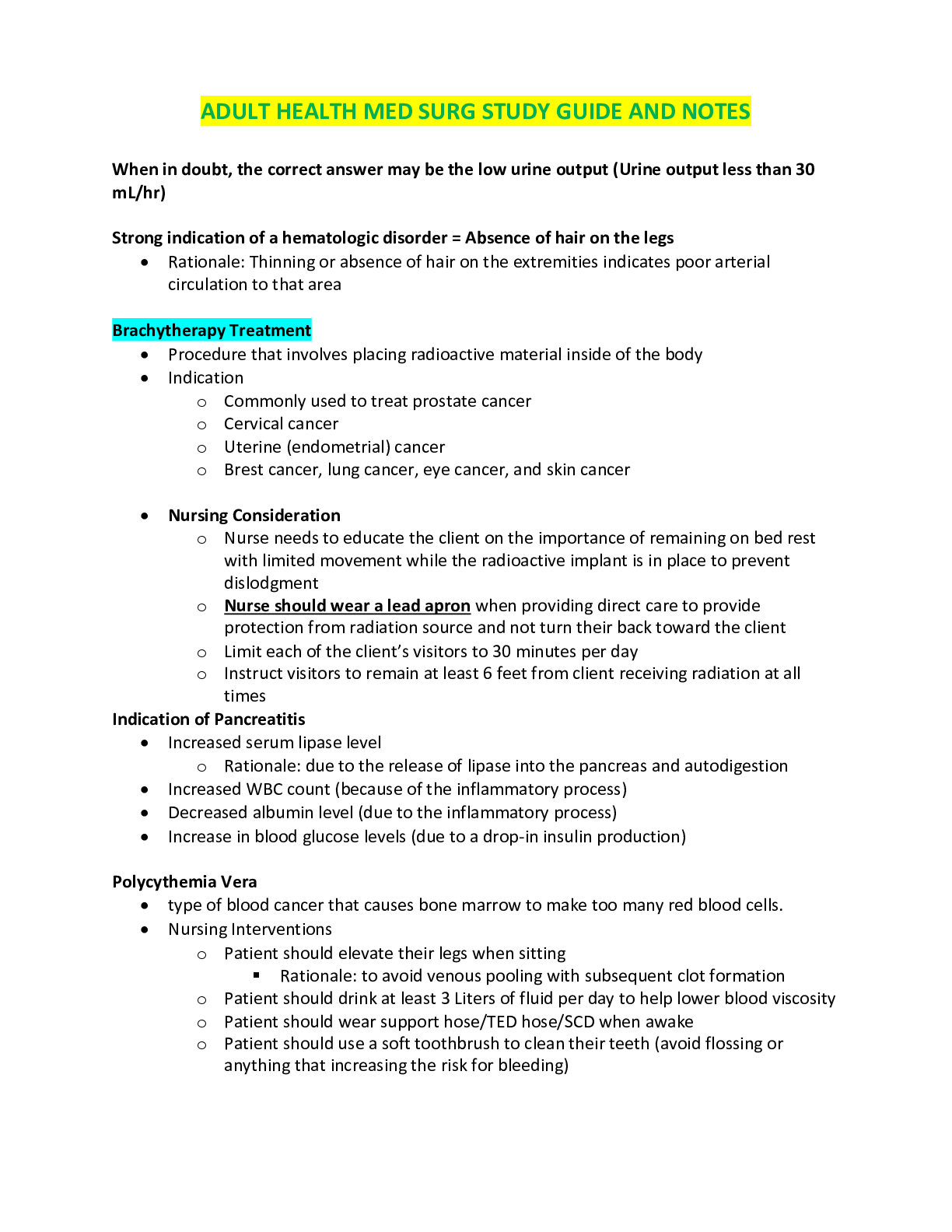*NURSING > MED-SURG EXAM > Med Surg Hesi practice questions With accurate answers, Latest update, Graded A (All)
Med Surg Hesi practice questions With accurate answers, Latest update, Graded A
Document Content and Description Below
Med Surg Hesi practice questions With accurate answers, Latest update, Graded A The nurse is assessing a 48-year-old client with a history of smoking during a routine clinic visit. The client, w... ho exercises regularly, reports having pain in the calf during exercise that disappears at rest. Which of the following findings requires further evaluation? 1. Heart rate 57 bpm. 2. SpO2 of 94% on room air. 3. Blood pressure 134/82. 4. Ankle-brachial index of 0.65. - ✔✔4 An Ankle-Brachial Index of 0.65 suggests moderate arterial vascular disease in a client who is experiencing intermittent claudication. A Doppler ultrasound is indicated for further evaluation. The bradycardic heart rate is acceptable in an athletic client with a normal blood pressure. The SpO2 is acceptable; the client has a smoking history. An overweight client taking warfarin (Coumadin) has dry skin due to decreased arterial blood flow. What should the nurse instruct the client to do? Select all that apply. 1. Apply lanolin or petroleum jelly to intact skin. 2. Follow a reduced-calorie, reduced-fat diet. 3. Inspect the involved areas daily for new ulcerations. 4. Instruct the client to limit activities of daily living (ADLs). 5.Use an electric razor to shave - ✔✔1,2,3,5 Maintaining skin integrity is important in preventing chronic ulcers and infections. The client should be taught to inspect the skin on a daily basis. The client should reduce weight to promote circulation; a diet lower in calories and fat is appropriate. Because the client is receiving Coumadin, the client is at risk for bleeding from cuts. To decrease the risk of cuts, the nurse should suggest that the client use an electric razor. The client with decreased arterial blood flow should be encouraged to participate in ADLs. In fact, the client should be encouraged to consult an exercise physiologist for an exercise program that enhances the aerobic capacity of the body. A client with peripheral vascular disease has undergone a right femoral-popliteal bypass graft. The blood pressure has decreased from 124/80 to 94/62. What should the nurse assess first? 1. IV fluid solution. 2. Pedal pulses. 3. Nasal cannula flow rate. 4. Capillary refill - ✔✔2 With each set of vital signs, the nurse should assess the dorsalis pedis and posterior tibial pulses. The nurse needs to ensure adequate perfusion to the lower extremity with the drop in blood pressure. IV fluids, nasal cannula setting, and capillary refill are important to assess; however, priority is to determine the cause of drop in blood pressure and that adequate perfusion through the new graft is maintained. The nurse is caring for a client with peripheral artery disease who has recently been prescribed clopidogrel (Plavix). The nurse understands that more teaching is necessary when the client states which of the following: 1. "I should not be surprised if I bruise easier or if my gums bleed a little when brushing my teeth." 2. "It doesn't really matter if I take this medicine with or without food, whatever works best for my stomach." 3. "I should stop taking Plavix if it makes me feel weak and dizzy." 4. "The doctor prescribed this medicine to make my platelets less likely to stick together and help prevent clots from forming." - ✔✔3 Weakness, dizziness, and headache are common adverse effects of Plavix and the client should report these to the physician if they are problematic; in order to decrease risk of clot formation, Plavix must be taken regularly and should not be stopped or taken intermittently. The main adverse effect of Plavix is bleeding, which often occurs as increased bruising or bleeding when brushing teeth. Plavix is well absorbed, and while food may help decrease potential gastrointestinal upset, Plavix may be taken with or without food. Plavix is an antiplatelet agent used to prevent clot formation in clients who have experienced or are at risk for myocardial infarction, ischemic stroke, peripheral artery disease, or acute coronary syndrome. A client is receiving Cilostazol (Pletal) for peripheral arterial disease causing intermittent claudication. The nurse determines this medication is effective when the client reports which of the following? 1. "I am having fewer aches and pains." 2. "I do not have headaches anymore." 3. "I am able to walk further without leg pain." 4. "My toes are turning grayish black in color." - ✔✔3 Cilostazol is indicated for management of intermittent claudication. Symptoms usually improve within 2 to 4 weeks of therapy. Intermittent claudication prevents clients from walking for long periods of time. Cilostazol inhibits platelet aggregation induced by various stimuli and improving blood flow to the muscles and allowing the client to walk long distances without pain. Peripheral arterial disease causes pain mainly of the leg muscles. "Aches and pains" does not specify exactly where the pain is occurring. Headaches may occur as a side effect of this drug, and the client should report this information to the health care provider. Peripheral arterial disease causes decreased blood supply to the peripheral tissues and may cause gangrene of the toes; the drug is effective when the toes are warm to the touch and the color of the toes is similar to the color of the body. The client admitted with peripheral vascular disease (PVD) asks the nurse why her legs hurt when she walks. The nurse bases a response on the knowledge that the main characteristic of PVD is: 1. Decreased blood flow. 2. Increased blood flow. 3. Slow blood flow. 4. Thrombus formation. - ✔✔1 Decreased blood flow is a common characteristic of all PVD. When the demand for oxygen to the working muscles becomes greater than the supply, pain is the outcome. Slow blood flow throughout the circulatory system may suggest pump failure. Thrombus formation can result from stasis or damage to the intima of the vessels. The nurse is planning care for a client who is diagnosed with peripheral vascular disease (PVD) and has a history of heart failure. The nurse should develop a plan of care that is based on the fact that the client may have a low tolerance for exercise related to: 1. Decreased blood flow. 2. Increased blood flow. 3. Decreased pain. 4. Increased blood viscosity. - ✔✔1 A client with PVD and heart failure will experience decreased blood flow. In this situation, low exercise tolerance (oxygen demand becomes greater than the oxygen supply) may be related to less blood being ejected from the left ventricle into the systemic circulation. Decreased blood supply to the tissues results in pain. Increased blood viscosity may be a component, but it is of much less importance than the disease processes. When assessing the lower extremities of a client with peripheral vascular disease (PVD), the nurse notes bilateral ankle edema. The edema is related to: 1. Competent venous valves. 2. Decreased blood volume. 3. Increase in muscular activity. 4. Increased venous pressure. - ✔✔4 In PVD, decreased blood flow can result in increased venous pressure. The increase in venous pressure results in an increase in capillary hydrostatic pressure, which causes a net filtration of fluid out of the capillaries into the interstitial space, resulting in edema. Valves often become incompetent with PVD. Blood volume is not decreased in this condition. Decreased muscular action would contribute to the formation of edema in the lower extremities. The nurse is obtaining the pulse of a client who has had a femoral-popliteal bypass surgery 6 hours ago. (See below) Which assessment provides the most accurate information about the client's postoperative status? 1. radial pulse 2. femoral pulse 3. apical pulse 4. dorsalis pedis pulse - ✔✔4 The presence of a strong dorsalis pedis pulse indicates that there is circulation to the extremity distal to the surgery indicating that the graft between the femoral and popliteal artery is allowing blood to circulate effectively. Answer 1 shows the nurse obtaining the radial pulse; answer 2 shows the femoral pulse, which is proximal to the surgery site and will not indicate circulation distal to the surgery site. Answer 3 shows the nurse obtaining an apical pulse. The nurse is teaching a client about risk factors associated with atherosclerosis and how to reduce the risk. Which of the following is a risk factor that the client is not able to modify? 1. Diabetes. 2. Age. 3. Exercise level. 4. Dietary preferences - ✔✔2 Age is a nonmodifiable risk factor for atherosclerosis. The nurse instructs the client to manage modifiable risk factors such as comorbid diseases (eg, diabetes), activity level, and diet. Controlling serum blood glucose levels, engaging in regular aerobic activity, and choosing a diet low in saturated fats can reduce the risk of developing atherosclerosis. The nurse is assessing the lower extremities of the client with peripheral vascular disease (PVD). During the assessment, the nurse should expect to find which of the following clinical manifestations of PVD? Select all that apply. 1. Hairy legs. 2. Mottled skin. 3. Pink skin. 4. Coolness. 5. Moist skin. - ✔✔2,4 Reduction of blood flow to a specific area results in decreased oxygen and nutrients. As a result, the skin may appear mottled. The skin will also be cool to the touch. Loss of hair and dry skin are other signs that the nurse may observe in a client with PVD of the lower extremities. The nurse is unable to palpate the client's left pedal pulses. Which of the following actions should the nurse take next? 1. Auscultate the pulses with a stethoscope. 2. Call the physician. 3. Use a Doppler ultrasound device. 4. Inspect the lower left extremity - ✔✔3 When pedal pulses are not palpable, the nurse should obtain a Doppler ultrasound device. Auscultation is not likely to be helpful if the pulse isn't palpable. Inspection of the lower extremity can be done simultaneously when palpating, but the nurse should first try to locate a pulse by Doppler. Calling the physician may be necessary if there is a change in the client's condition. Which of the following lipid abnormalities is a risk factor for the development of atherosclerosis and peripheral vascular disease? 1. Low concentration of triglycerides. 2. High levels of high-density lipid (HDL) cholesterol. 3. High levels of low-density lipid (LDL) cholesterol. 4. Low levels of LDL cholesterol. - ✔✔3 An increased LDL cholesterol concentration has been documented as a risk factor for the development of atherosclerosis. LDL cholesterol is not broken down in the liver but is deposited into the intima of the blood vessels. Low triglyceride levels are desirable. High HDL and low LDL levels are beneficial and are known to be protective for the cardiovascular system. When assessing an individual with peripheral vascular disease, which clinical manifestation would indicate complete arterial obstruction in the lower left leg? 1. Aching pain in the left calf. 2. Burning pain in the left calf. 3. Numbness and tingling in the left leg. 4. Coldness of the left foot and ankle - ✔✔4 Coldness in the left foot and ankle is consistent with complete arterial obstruction. Other expected findings would include paralysis and pallor. Aching pain, a burning sensation, or numbness and tingling are earlier signs of tissue hypoxia and ischemia and are commonly associated with incomplete obstruction. A client with peripheral vascular disease returns to the surgical care unit after having femoral-popliteal bypass grafting. Indicate in which order the nurse should conduct assessment of this client. 1. Postoperative pain. 2. Peripheral pulses. 3. Urine output. 4. Incision site. - ✔✔(2,4,3,1) Because assessment of the presence and quality of the pedal pulses in the affected extremity is essential after surgery to make sure that the bypass graft is functioning, this step should be done first. The nurse should next ensure that the dressing is intact, and then that the client has adequate urine output. Lastly, the nurse should determine the client's level of pain. A client with heart failure has bilateral +4 edema of the right ankle that extends up to midcalf. The client is sitting in a chair with the legs in a dependent position. Which of the following goals is the priority? 1. Decrease venous congestion. 2. Maintain normal respirations. 3. Maintain body temperature. 4. Prevent injury to lower extremities. - ✔✔1 Decreasing venous congestion in the extremities is a desired outcome for clients with heart failure. The nurse should elevate the client's legs above the level of the heart to achieve this goal. The client is not demonstrating difficulty breathing or being cold. The nurse should prevent injury to the swollen extremity; however, this is not the priority. The nurse is assessing an older Caucasian male who has a history of peripheral vascular disease. The nurse observes that the man's left great toe is black. The discoloration is probably a result of: 1. Atrophy. 2. Contraction. 3. Gangrene. 4. Rubor. - ✔✔3 The term gangrene refers to blackened, decomposing tissue that is devoid of circulation. Chronic ischemia and death of the tissue can lead to gangrene in the affected extremity. Injury, edema, and decreased circulation lead to infection, gangrene, and tissue death. Atrophy is the shrinking of tissue, and contraction is joint stiffening secondary to disuse. The term rubor denotes a reddish color of the skin A client has peripheral vascular disease (PVD) of the lower extremities. The client tells the nurse, "I've really tried to manage my condition well." Which of the following routines should the nurse evaluate as having been appropriate for this client? 1. Resting with the legs elevated above the level of the heart. 2. Walking slowly but steadily for 30 minutes twice a day. 3. Minimizing activity. 4. Wearing antiembolism stockings at all times when out of bed - ✔✔2 Slow, steady walking is a recommended activity for clients with peripheral vascular disease because it stimulates the development of collateral circulation. The client with PVD should not remain inactive. Elevating the legs above the heart or wearing antiembolism stockings is a strategy for alleviating venous congestion and may worsen peripheral arterial disease A client is scheduled for an arteriogram. The nurse should explain to the client that the arteriogram will confirm the diagnosis of occlusive arterial disease by: 1. Showing the location of the obstruction and the collateral circulation. 2. Scanning the affected extremity and identifying the areas of volume changes. 3. Using ultrasound to estimate the velocity changes in the blood vessels. 4. Determining how long the client can walk. - ✔✔1 An arteriogram involves injecting a radiopaque contrast agent directly into the vascular system to visualize the vessels. It usually involves computed tomographic scanning. The velocity of the blood flow can be estimated by duplex ultrasound. The client's ankle-brachial index is determined, and then the client is requested to walk. The normal response is little or no drop in ankle systolic pressure after exercise. A client is scheduled to have an arteriogram. During the arteriogram, the client reports having nausea, tingling, and dyspnea. The nurse's immediate action should be to: 1. Administer epinephrine. 2. Inform the physician. 3. Administer oxygen. 4. Inform the client that the procedure is almost over. - ✔✔2 .Clients may have an immediate or a delayed reaction to the radiopaque dye. The physician should be notified immediately because the symptoms suggest an allergic reaction. Treatment may involve administering oxygen and epinephrine. Explaining that the procedure is over does not address the current symptoms Which of the following is an expected outcome when a client is receiving an IV administration of furosemide? 1. Increased blood pressure. 2. Increased urine output. 3. Decreased pain. 4. Decreased premature ventricular contractions. - ✔✔2 Furosemide is a loop diuretic that acts to increase urine output. Furosemide does not increase blood pressure, decrease pain, or decrease arrhythmias. A client has had a pulmonary artery catheter inserted. In performing hemodynamic monitoring with the catheter, the nurse will wedge the catheter to gain information about which of the following? 1. Cardiac output. 2. Right atrial blood flow. 3. Left end-diastolic pressure. 4. Cardiac index - ✔✔3 When wedged, the catheter is "pointing" indirectly at the left end-diastolic pressure. The pulmonary artery wedge pressure is measured when the tip of the catheter is slowing inflated and allowed to wedge into a branch of the pulmonary artery. Once the balloon is wedged, the catheter reads the pressure in front of the balloon. During diastole, the mitral valve is open, reflecting left ventricular end diastolic pressure. Cardiac output is the amount of blood ejected by the heart in 1 minute and is determined through thermodilution and not wedge pressure. Cardiac index is calculated by dividing the client's cardiac output by the client's body surface area, and is considered a more accurate reflection of the individual client's cardiac output. Right atrial blood pressure is not measured with the pulmonary artery catheter. After a myocardial infarction, the hospitalized client is taught to move the legs while resting in bed. The expected outcome of this exercise is to: 1. Prepare the client for ambulation. 2. Promote urinary and intestinal elimination. 3. Prevent thrombophlebitis and blood clot formation. 4. Decrease the likelihood of pressure ulcer formation. - ✔✔3 Encouraging the client to move the legs while in bed is a preventive strategy taught to all clients who are hospitalized and on bed rest to promote venous return. The muscular action aids in venous return and prevents venous stasis in the lower extremities. These exercises are not intended to prepare the client for ambulation. These exercises are not associated with promoting urinary and intestinal elimination. These exercises are not performed to decrease the risk of pressure ulcer formation Which of the following is the most appropriate diet for a client during the acute phase of myocardial infarction? 1. Liquids as desired. 2. Small, easily digested meals. 3. Three regular meals per day. 4. Nothing by mouth - ✔✔2 Recommended dietary principles in the acute phase of MI include avoiding large meals because small, easily digested foods are better tolerated. Fluids are given according to the client's needs, and sodium restrictions may be prescribed, especially for clients with manifestations of heart failure. Cholesterol restrictions may be prescribed as well. Clients are not prescribed diets of liquids only or restricted to nothing by mouth unless their condition is very unstable. The nurse is caring for a client who recently experienced a myocardial infarction and has been started on clopidogrel (Plavix). The nurse should develop a teaching plan that includes which of the following points? Select all that apply. 1. The client should report unexpected bleeding or bleeding that lasts a long time. 2. The client should take Plavix with food. 3. The client may bruise more easily and may experience bleeding gums. 4. Plavix works by preventing platelets from sticking together and forming a clot. 5. The client should drink a glass of water after taking Plavix. - ✔✔1,3,4 Plavix is generally well absorbed and may be taken with or without food; it should be taken at the same time every day and, while food may help prevent potential GI upset, food has no effect on absorption of the drug. Bleeding is the most common adverse effect of Plavix; the client must understand the importance of reporting any unexpected, prolonged, or excessive bleeding including blood in urine or stool. Increased bruising and bleeding gums are possible side effects of Plavix; the client should be aware of this possibility. Plavix is an antiplatelet agent used to prevent clot formation in clients that have experienced or are at risk for myocardial infarction, ischemic stroke, peripheral artery disease, or acute coronary syndrome. It is not necessary to drink a glass of water after taking Plavix. Which client is at greatest risk for coronary artery disease? 1. A 32-year-old female with mitral valve prolapse who quit smoking 10 years ago. 2. A 43-year-old male with a family history of CAD and cholesterol level of 158 (8.8 mmol/L). 3. A 56-year-old male with an HDL of 60 (3.3 mmol/L) who takes atorvastatin. 4. A 65-year-old female who is obese with an LDL of 188 (10.4 mmol/L). - ✔✔4 The woman who is 65 years old, overweight, and has an elevated LDL is at greatest risk. Total cholesterol greater than 200 (11.1 mmol/L), LDL greater than 100 (5.5 mmol/L), HDL less than 40 (2.2 mmol/L) in men, HDL less than 50 (2.8 mmol/L) in women, men 45 years and older, women 55 years and older, smoking and obesity increase the risk of CAD. Atorvastatin reduces LDL and decreases risk of CAD. The combination of postmenopausal, obesity, and high LDL places this client at greatest risk. . A middle-aged adult with a family history of CAD has the following: total cholesterol 198 (11 mmol/L); LDL cholesterol 120 (6.7 mmol/L); HDL cholesterol 58 (3.2 mmol/L); triglycerides 148 (8.2 mmol/L); blood sugar 102 (5.7 mmol/L); and Creactive protein (CRP) 4.2. The health care provider prescribes a statin medication and aspirin. The client asks the nurse why these medications are needed. Which is the best response by the nurse? 1. "The labs indicate severe hyperlipidemia and the medications will lower your LDL, along with a low-fat diet." 2. "The triglycerides are elevated and will not return to normal without these medications." 3. "The CRP is elevated indicating inflammation seen in cardiovascular disease, which can be lowered by the medications prescribed." 4. "These medications will reduce the risk of type 2 diabetes." - ✔✔3 CRP is a marker of inflammation and is elevated in the presence of cardiovascular disease. The high sensitivity CRP (hs-CRP) is the blood test for greater accuracy in measuring the CRP to evaluate cardiovascular risk. The family history, postmenopausal age, LDL above optimum levels, and elevated CRP place the client at risk of CAD. Statin medications can decrease LDL, whereas statins and aspirin can reduce CRP and decrease the risk of MI and stroke. The blood sugar is within normal limits. The client has been managing angina episodes with nitroglycerin. Which of the following indicate the drug is effective? 1. Decreased chest pain. 2. Increased blood pressure. 3. Decreased blood pressure. 4. Decreased heart rate - ✔✔1 Nitroglycerin acts to decrease myocardial oxygen consumption. Vasodilation makes it easier for the heart to eject blood, resulting in decreased oxygen needs. Decreased oxygen demand reduces pain caused by heart muscle not receiving sufficient oxygen. While blood pressure may decrease ever so slightly due to the vasodilation effects of nitroglycerine, it is only secondary and not related to the angina the patient is experiencing. Increased blood pressure would mean the heart would work harder, increasing oxygen demand and thus angina. Decreased heart rate is not an effect of nitroglycerine. If a client displays risk factors for coronary artery disease, such as smoking cigarettes, eating a diet high in saturated fat, or leading a sedentary lifestyle, techniques of behavior modification may be used to help the client change the behavior. The nurse can best reinforce new adaptive behaviors by: 1. Explaining how the risk factor behavior leads to poor health. 2. Withholding praise until the new behavior is well established. 3. Rewarding the client whenever the acceptable behavior is performed. 4. Instilling mild fear into the client to extinguish the behavior. - ✔✔3 A basic principle of behavior modification is that behavior that is learned and continued is behavior that has been rewarded. Other reinforcement techniques have not been found to be as effective as reward. Alteplase recombinant, or tissue plasminogen activator (t-PA), a thrombolytic enzyme, is administered during the first 6 hours after onset of myocardial infarction (MI) to: 1. Control chest pain. 2. Reduce coronary artery vasospasm. 3. Control the arrhythmias associated with MI. 4. Revascularize the blocked coronary artery. - ✔✔4 The thrombolytic agent t-PA, administered intravenously, lyses the clot blocking the coronary artery. The drug is most effective when administered within the first 6 hours after onset of MI. The drug does not reduce coronary artery vasospasm; nitrates are used to promote vasodilation. Arrhythmias are managed by antiarrhythmic drugs. Surgical approaches are used to open the coronary artery and re-establish a blood supply to the area. After the administration of t-PA, the nurse should: 1. Observe the client for chest pain. 2. Monitor for fever. 3. Review the 12-lead electrocardiogram (ECG). 4. Auscultate breath sounds - ✔✔1 Although monitoring the 12-lead ECG and monitoring breath sounds are important, observing the client for chest pain is the nursing assessment priority because closure of the previously obstructed coronary artery may recur. Clients who receive t- PA frequently receive heparin to prevent closure of the artery after administration of t- PA. Careful assessment for signs of bleeding and monitoring of partial thromboplastin time are essential to detect complications. Administration of t-PA should not cause fever. When monitoring a client who is receiving tissue plasminogen activator (t-PA), the nurse should have resuscitation equipment available because reperfusion of the cardiac tissue can result in which of the following? 1. Cardiac arrhythmias. 2. Hypertension. 3. Seizure. 4. Hypothermia. - ✔✔1 Cardiac arrhythmias are commonly observed with administration of t-PA. Cardiac arrhythmias are associated with reperfusion of the cardiac tissue. Hypotension is commonly observed with administration of t-PA. Seizures and hypothermia are not generally associated with reperfusion of the cardiac tissue. Prior to administering tissue plasminogen activator (t-PA), the nurse should assess the client for which of the following contradictions to administering the drug? 1. Age greater than 60 years. 2. History of cerebral hemorrhage. 3. History of heart failure. 4. Cigarette smoking. - ✔✔2 A history of cerebral hemorrhage is a contraindication to administration of t- PA because the risk of hemorrhage may be further increased. Age greater than 60 years, history of heart failure, and cigarette smoking are not contraindications. A client has driven himself to the emergency department. He is 50 years old, has a history of hypertension, and informs the nurse that his father died from a heart attack at age 60. The client has indigestion. The nurse connects him to an electrocardiogram monitor and begins administering oxygen at 2 L/min per nasal cannula. The nurse's next action should be to: 1. Call for the physician. 2. Start an IV infusion. 3. Obtain a portable chest radiograph. 4. Draw blood for laboratory studies - ✔✔2 Advanced cardiac life support recommends that at least one or two IV lines be inserted in one or both of the antecubital spaces. Calling the physician, obtaining a portable chest radiograph, and drawing blood for the laboratory are important but secondary to starting the IV line. Crackles heard on lung auscultation indicate which of the following? 1. Cyanosis. 2. Bronchospasm. 3. Airway narrowing. 4.Fluid-filled alveoli. - ✔✔4 Crackles are auscultated over fluid-filled alveoli. Crackles heard on lung auscultation do not have to be associated with cyanosis. Bronchospasm and airway narrowing generally are associated with wheezing sounds. A 68-year-old client on day 2 after hip surgery has no cardiac history but reports having chest heaviness. The first nursing action should be to: 1. Inquire about the onset, duration, severity, and precipitating factors of the heaviness. 2. Administer oxygen via nasal cannula. 3. Offer pain medication for the chest heaviness. 4. Inform the physician of the chest heaviness. - ✔✔1 Further assessment is needed in this situation. It is premature to initiate other actions until further data have been gathered. Inquiring about the onset, duration, location, severity, and precipitating factors of the chest heaviness will provide pertinent information to convey to the physician. The nurse is assessing an older adult with a pacemaker who leads a sedentary lifestyle. The client reports being unable to perform activities that require physical exertion. The nurse should further assess the client for which of the following? 1. Left ventricular atrophy. 2. Irregular heartbeats. 3. Peripheral vascular occlusion. 4. Pacemaker placement - ✔✔1 In older adults who are less active and do not exercise the heart muscle, atrophy can result. Disuse or deconditioning can lead to abnormal changes in the myocardium of the older adult. As a result, under sudden emotional or physical stress, the left ventricle is less able to respond to the increased demands on the myocardial muscle. Decreased cardiac output, cardiac hypertrophy, and heart failure are examples of the chronic conditions that may develop in response to inactivity, rather than in response to the aging process. Irregular heartbeats are generally not associated with an older sedentary adult's lifestyle. Peripheral vascular occlusion or pacemaker placement should not affect response to stress. . Following diagnosis of angina pectoris, a client reports being unable to walk up two flights of stairs without pain. Which of the following measures would most likely help the client prevent this problem? 1. Climb the steps early in the day. 2. Rest for at least an hour before climbing the stairs. 3. Take a nitroglycerin tablet before climbing the stairs. 4. Lie down after climbing the stairs. - ✔✔3 Nitroglycerin may be used prophylactically before stressful physical activities such as stair climbing to help the client remain pain free. Climbing the stairs early in the day would have no impact on decreasing pain episodes. Resting before or after an activity is not as likely to help prevent an activity-related pain episode. The client who experiences angina has been told to follow a low-cholesterol diet. Which of the following meals would be best? 1. Hamburger, salad, and milkshake. 2. Baked liver, green beans, and coffee. 3. Spaghetti with tomato sauce, salad, and coffee. 4. Fried chicken, green beans, and skim milk - ✔✔3 Pasta, tomato sauce, salad, and coffee would be the best selection for the client following a low-cholesterol diet. Hamburgers, milkshakes, liver, and fried foods tend to be high in cholesterol. The nurse should caution the client with diabetes mellitus who is taking a sulfonylurea that alcoholic beverages should be avoided while taking these drugs because they can cause which of the following? 1. Hypokalemia. 2. Hyperkalemia. 3. Hypocalcemia. 4.Disulfiram (Antabuse)-like symptoms - ✔✔4 A client with diabetes who takes any first- or second-generation sulfonylurea should be advised to avoid alcohol intake. Sulfonylureas in combination with alcohol can cause serious disulfiram (Antabuse)-like reactions, including flushing, angina, palpitations, and vertigo. Serious reactions, such as seizures and possibly death, may also occur. Hypokalemia, hyperkalemia, and hypocalcemia do not result from taking sulfonylureas in combination with alcohol. Which of the following conditions is the most significant risk factor for the development of type 2 diabetes mellitus? 1. Cigarette smoking. 2. High-cholesterol diet. 3. Obesity. 4. Hypertension. - ✔✔3 The most important factor predisposing to the development of type 2 diabetes mellitus is obesity. Insulin resistance increases with obesity. Cigarette smoking is not a predisposing factor, but it is a risk factor that increases complications of diabetes mellitus. A high-cholesterol diet does not necessarily predispose to diabetes mellitus, but it may contribute to obesity and hyperlipidemia. Hypertension is not a predisposing factor, but it is a risk factor for developing complications of diabetes mellitus. Which of the following indicates a potential complication of diabetes mellitus? 1. Inflamed, painful joints. 2. Blood pressure of 160/100 mm Hg. 3. Stooped appearance. 4. Hemoglobin of 9 g/dL (90 g/L). - ✔✔2 The client with diabetes mellitus is especially prone to hypertension due to atherosclerotic changes, which leads to problems of the microvascular and macrovascular systems. This can result in complications in the heart, brain, and kidneys. Heart disease and stroke are twice as common among people with diabetes mellitus as among people without the disease. Painful, inflamed joints accompany rheumatoid arthritis. A stooped appearance accompanies osteoporosis with narrowing of the vertebral column. A low hemoglobin concentration accompanies anemia, especially iron deficiency anemia and anemia of chronic disease. The nurse is teaching the client about home blood glucose monitoring. Which of the following blood glucose measurements indicates hypoglycemia? 1. 59 mg/dL (3.3 mmol/L). 2. 75 mg/dL (4.2 mmol/L). 3. 108 mg/dL (6 mmol/L). 4. 119 mg/dL (6.6 mmol/L). - ✔✔1 Although some individual variation exists, when the blood glucose level decreases to less than 70 mg/dL (3.9 mmol/L), the client experiences or is at risk for hypoglycemia. Hypoglycemia can occur in both type 1 and type 2 diabetes mellitus [Show More]
Last updated: 1 year ago
Preview 1 out of 53 pages
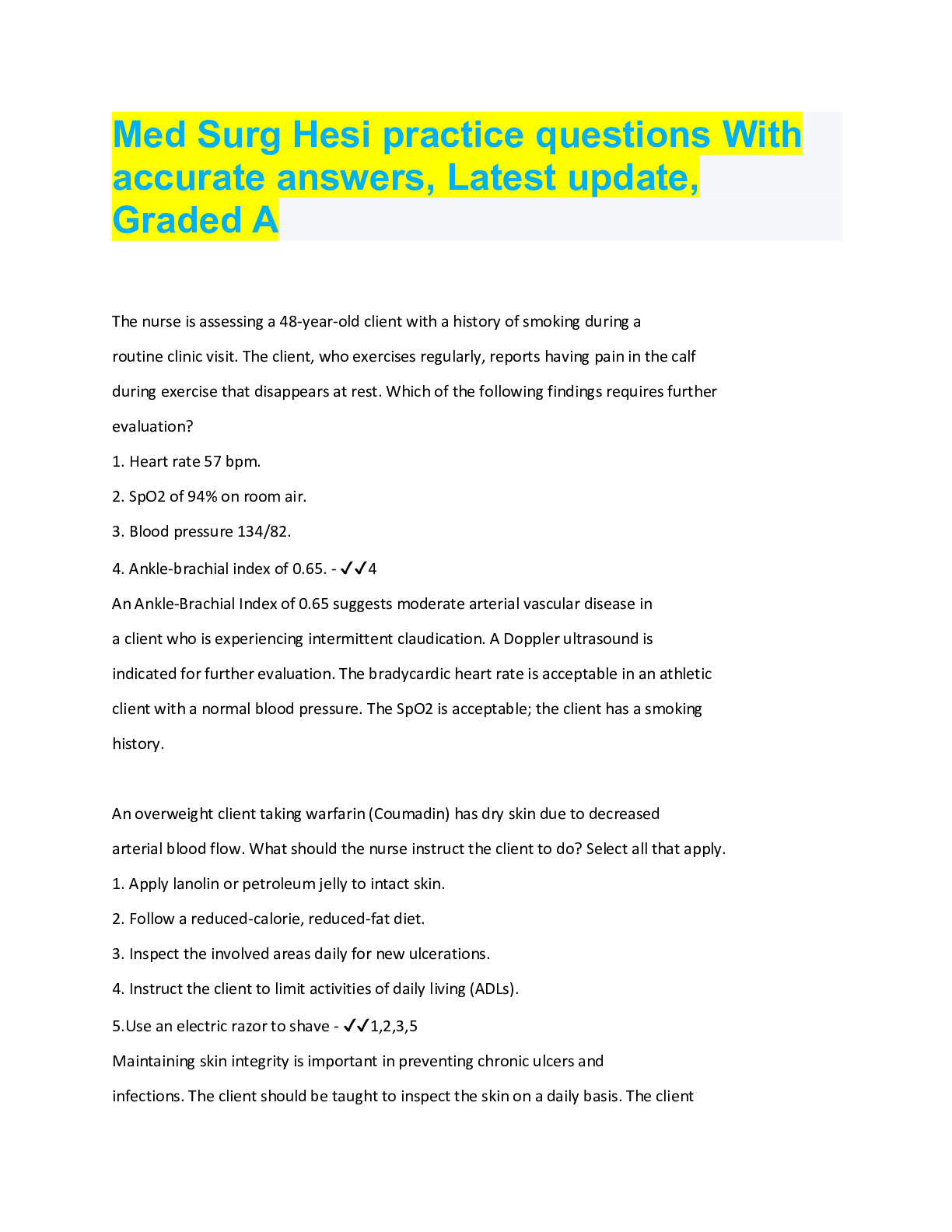
Reviews( 0 )
Document information
Connected school, study & course
About the document
Uploaded On
Oct 03, 2022
Number of pages
53
Written in
Additional information
This document has been written for:
Uploaded
Oct 03, 2022
Downloads
0
Views
103



